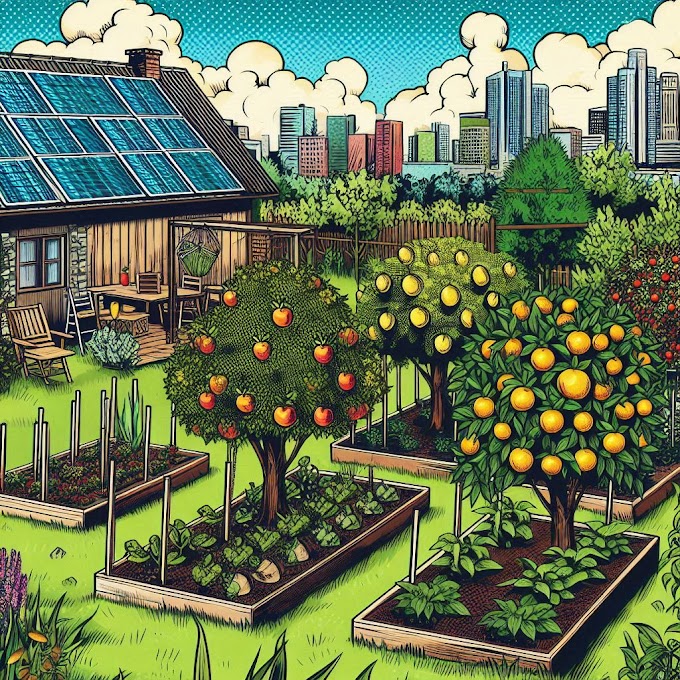Survival Gardening: Growing Your Own Food for Self-Sufficiency and Resilience

In uncertain times, having access to fresh, nutritious food is essential for survival and resilience. One way to ensure food security is by cultivating a survival garden—a garden designed to provide a steady supply of fruits, vegetables, and herbs for sustenance and self-sufficiency.
In this article, we'll explore the principles of survival gardening, essential crops to grow, tips for success, and how to maximize your garden's productivity to meet your food needs.
1. Understanding Survival Gardening:
- Self-Sufficiency: Survival gardening is about taking control of your food supply and reducing reliance on grocery stores and external sources for sustenance. By growing your own food, you can ensure access to fresh, nutritious produce, even in times of crisis or scarcity.
- Resilience: Survival gardening enhances resilience by providing a buffer against food shortages, price fluctuations, and disruptions in supply chains. A well-planned survival garden can help you weather unforeseen challenges and maintain food security for yourself and your family.
- Sustainability: Survival gardening promotes sustainable agriculture practices, such as organic gardening, permaculture, and regenerative farming, which minimize environmental impact and promote soil health, biodiversity, and ecosystem resilience.
2. Essential Crops for Survival Gardening:
- Leafy Greens: Leafy greens such as kale, spinach, lettuce, and Swiss chard are nutrient-dense crops that provide essential vitamins, minerals, and antioxidants for health and vitality. They're easy to grow and can be harvested continuously for salads, soups, stir-fries, and smoothies.
- Root Vegetables: Root vegetables like carrots, potatoes, beets, and radishes are hearty, calorie-rich crops that store well and provide sustained energy. They're versatile ingredients for roasting, steaming, baking, and boiling, and can be preserved through canning, freezing, or root cellar storage.
- Tomatoes: Tomatoes are prolific producers that thrive in a variety of climates and soil conditions. They're rich in vitamins, minerals, and antioxidants and can be eaten fresh, cooked, or preserved as sauces, salsas, and canned goods for year-round enjoyment.
- Beans and Legumes: Beans and legumes such as peas, beans, lentils, and chickpeas are excellent sources of plant-based protein, fiber, and essential nutrients. They fix nitrogen in the soil, enriching fertility and supporting the growth of other crops in the garden.
- Herbs: Herbs like basil, parsley, cilantro, and mint add flavor, aroma, and nutritional value to meals while providing natural pest control and medicinal benefits. They're easy to grow in containers, raised beds, or garden plots and can be dried, frozen, or preserved for culinary and therapeutic use.
3. Tips for Success in Survival Gardening:
- Start Small: Begin with a manageable garden plot or container garden and gradually expand as you gain experience and confidence in your gardening skills.
- Plan and Prepare: Plan your garden layout and crop selection based on your space, climate, soil type, and growing season. Prepare the soil by amending with compost, mulch, and organic matter to improve fertility, structure, and water retention.
- Practice Permaculture Principles: Embrace permaculture principles such as diversity, polyculture, companion planting, and mulching to create a resilient and self-sustaining ecosystem that mimics natural patterns and processes.
- Save Seeds and Preserve Harvests: Save seeds from heirloom and open-pollinated varieties to ensure genetic diversity and long-term resilience in your garden. Preserve excess harvests through canning, freezing, drying, fermenting, or root cellar storage to extend shelf life and minimize waste.
- Stay Flexible and Adapt: Be flexible and adaptable in your gardening approach, adjusting planting schedules, irrigation methods, and pest management strategies as needed to respond to changing conditions and challenges.
4. Maximizing Garden Productivity:
- Succession Planting: Plant crops in succession to maximize space and extend the growing season, staggering plantings for continuous harvests throughout the year.
- Vertical Gardening: Utilize vertical space with trellises, arbors, and vertical planters to grow vining crops such as tomatoes, cucumbers, beans, and peas, optimizing sunlight exposure and airflow.
- Intensive Planting: Practice intensive planting techniques such as square foot gardening, raised beds, and intercropping to maximize yield per square foot and minimize wasted space.
- Crop Rotation: Rotate crops annually to prevent soil depletion, nutrient imbalances, and pest and disease buildup, promoting soil health and fertility over time.
In conclusion, survival gardening is a practical and empowering way to enhance food security, self-sufficiency, and resilience in uncertain times.
By cultivating a diverse and productive garden with essential crops, practicing sustainable gardening techniques, and staying adaptable to changing conditions, you can nourish yourself and your family with fresh, nutritious food while reconnecting with the rhythms of nature and the joy of gardening.
Tips for Success in Survival Gardening:
1. Start with essential crops that are easy to grow and provide maximum nutrition and versatility.
2. Plan your garden layout and crop selection based on your space, climate, and growing season.
3. Incorporate sustainable gardening practices such as composting, mulching, and water conservation to promote soil health and biodiversity.
4. Stay flexible and adaptable in your gardening approach, adjusting to changing conditions and challenges as they arise.
5. Share your knowledge and abundance with others in your community, fostering resilience and cooperation in times of need.













